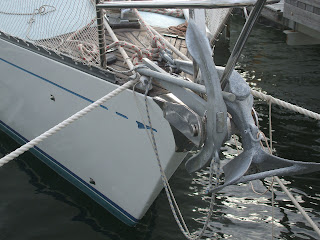


I sorted out some anchor issues yesterday to great relief and satisfaction. The main question was how to store and deploy the Swarbrick Fisherman-style anchor. Fisherman anchors are probably the best all-around anchors (e.g. they punch through weed, cling to rock crevices, hold in mud and sand) but they have gone out of favour largely because they are so difficult to store and deploy.
The attached photos show the Swarbrick 35lb anchor on the starboard roller next to the Manson 45-lb plow. You can see that the plow anchor can be dropped and retrieved with no interference from the Swarbrick. To deploy the Swarbrick I (1) push the anchor to where it is hanging vertically from the roller (2) pull back on the trip line to steady the anchor and also raise it a bit from the water (3) on my stomach I position the stock. When I get to the drop point I'll ease the trip line and gently drop the anchor. Retrieval is the reverse: bring the anchor up to the roller, steady it with the trip line, move the stock to the storage position, then yank the anchor onto the roller.
The stomach operation is better than it looks: easy on the back, safe because I am down low, and requires no risky movements. Approaching an anchorage in rough conditions could pose a problem, but you've got to ask how suitable would be an anchorage where the bow of the boat is plunging in and out of the water. Nevertheless if such conditions do arise I'll drop the plow anchor.
Note that the ropes were experimental only. My 38m of 10mm chain is being re galvanised. I'll probably purchase a 15m chain for the second anchor. Both anchors will have 100 meters or so of 16mm nylon rope. Also, Scotty is fabricating generous stainless steel armor for the bow to protect it from swinging anchors.
Harley Swarbrick phoned me last week to tell me that he expected to put together this week the 50lb anchor that I have ordered. The span across the arms and the length of shank of the larger anchor are less than 100mm (4") more than those of the 35lb anchor, so I anticipate no problem with putting it on the roller.
So which are the primary and secondary anchors? Who knows. I'll probably start out with the Swarbrick 35lb and the Manson plow anchors on the roller, as show on the photos. Each anchor has its advantages, so I'll drop one or the other depending on what I think is the holding ground. The Swarbrick 50lb will be a storm anchor.
One of the problems of an S&S 39 is that it is sensitive to weight at the bow because its forward section is so long and slender. That is one reason why I can't have all-chain rodes. So I'll store the Swarbrick 50lb and spare chain at the stern to trim the boat.
All peer reviews welcome!

2 comments:
Hello Bob
You are still rather busy getting this yacht A1! Tell me, how do you keep it safely moored? Friends from Condingup have had their boat go astray two Sundays, a fortnight apart from a sheltered spot just east of Wharton Beach to the south of Condingup. The first time a neighbouring boat was manned and they saved it. The weekend before last the weather was rough and it went east, only to be finally found Saturday in a million pieces washed up on a beach about 20km east. This was a 25ft wooden boat covered in fiberglass so never leaked. Now the owner is searching for a 30footer, the bigger the better! BTW another boat moored in that area was sunk on a Sunday in the last month. I doubt there is a religious link!
Chris
A good start would be to identify what went failed with these moorings e.g. broken mooring lines? swivel failure? dragging anchor?
Assuming that the location of the mooring is appropriately sheltered from heavy winds and seas I believe that a mooring should grip into the sea floor and not be just a dead weight resting on the bottom. My mooring at Mangles Bay was made up of three heavy anchors made out of heavy steel RSJ's. One anchor faced the SW one the NW, and one the E. An anchor to the NW was particularly important because the worst storms came from this direction. The anchors were connected at the centre to a swivel via ground chains. The swivel is a shackle that allows 360 degree movement so that the boat can swing around and around without twisting up the lines. To the swivel was connected the heaviest chain that I could find. This is known as the "riser". From the end of the riser were two ropes connected to the boat. The riser should be no longer than the length of the ground chains, lest they dig out the anchors as the boat swings around. This riser acts like a big spring, minimizing direct strain on the anchors. Over the years I saw at least 50 boats washed up on the beach after storms but mine always survived. To sum up, you need (1) good location (2) good mooring design and materials (3) good ongoing maintenance.
Post a Comment